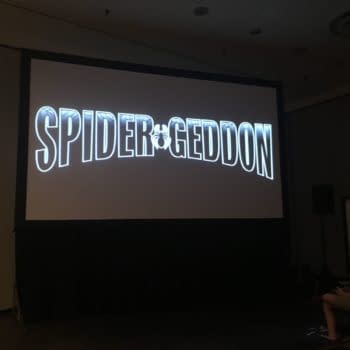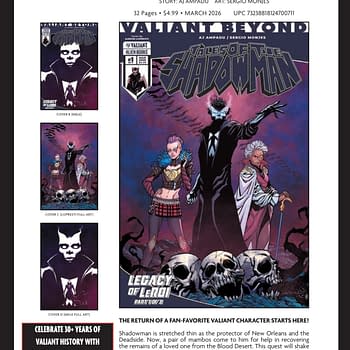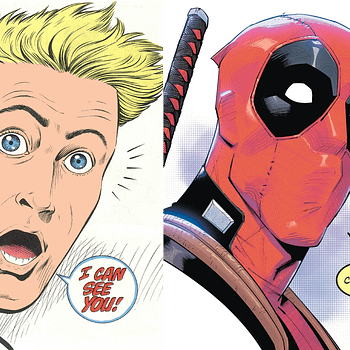Posted in: Comics | Tagged: jeff lemire, royal city
Talking To Jeff Lemire About His Royal City
When he began in comics over a decade ago, Jeff Lemire started off on the indie side of things. Since then, he's forged a path that's taken him from everything to Marvel and DC Comics to everything in between. With an impressive body of work to his name, the creator keeps churning out book after book. Mr. Lemire's latest comic book takes him, and the audience, back to his indie roots. A couple of weeks ago, the first issue of Royal City hit the stands; I couldn't think of a better time to speak to the illustrious author.
Octavio Karbank: Okay, let's get the basic questions out of the way. What's Royal City about?
Jeff Lemire: Royal City follows the Pike family, who live in a small town somewhere in North America. I purposefully don't say where it is; it's a generic small town that has seen better days. You have these smaller cities that were once driving communities and have found themselves in between being small towns that can barely sustain themselves and a big city, but they're not really that either. We focus on their family, adults who are at various crossroads in their life and come together after their father has a stroke in the first issue. Over the course of the first two issues, we learn about each of their lives, but also learn of this connecting thread, the long sibling Tommy, who died when they were all teenagers in the 90s. His ghost is quite literally haunting them all still and holding them all back.
OK: How many issues will it be?
JL: The first issue was double-sized so that I could really establish everything that I wanted to. Right now I have the series plotted 15-20 issues long. I'm leaving a little room in case things take off. That's what happened when I wrote Sweet Tooth. I planned for it to be 24 issues, but it turned into 40. You start to introduce side characters and they take off and you explore their stories.
OK: While reading Royal City, I couldn't help but notice that it is a very grounded story.
JL: It's close to two places for me. When I first started my career as a cartoonist, which was back eleven years ago now, in 2006, I published the first volume of my Essex County trilogy for Top Shelf at that time. I did very grounded stories, set in the "real world." It wasn't supernatural or anything like that, but it was about "real" people." Since then my career has gone in all sorts of directions and I've done a bunch of different genres like with Marvel and DC, and even Image; I love doing it. Yet 10 years into my career I have this longing to go back to my roots and do something like Essex County again. When I talked about this with Eric Stephenson, the publisher at Image, we had a conversation about it and I became really fascinated with doing a story like Essex County, but instead of doing it like an original graphic novel, I'd do it as an ongoing series. There really isn't a lot of that right now; most stuff these days is really genre-based. There isn't anything really being done in the tradition of just real people in a real world and on an ongoing basis. I became really interested in the challenge of doing that.
OK: Are there any autobiographical elements to the story?
JL: It's interesting, because like with Essex County that was a question I faced too. Essex County was set in the real town where I grew up, but none of it was straight autobiography. It was more like a jigsaw puzzle; I was just taking things from my life and mixing them into something new. In Royal City, the protagonist, I guess, is the character Patrick. There are a lot of similarities between he and I. We're both the same age, he grew up in a small community and moved off to the big city just like I did and pursued a career as a writer and became quite successful at doing it. I guess there are parallels there, but then I had fun with the character and sort of imagined if I had made all the wrong decisions with both my personal life and career. Patrick achieves success and then kind of spirals; that's where I live vicariously through Patrick and see how that character self-destructs. He's become this polar opposite of me, but also this weird doppelganger. Even the other characters have pieces of myself and bit of other people I know and things I read. It's nothing completely autobiographical, but you certainly put a lot of yourself into something like this.
OK: With Patrick, who we'll call the protagonist, one of the themes for him was finding success and then being unsure how to recreate that. Is that something that's weighted on you?
JL: Oh yeah, it was hard. When I first started, Essex County came out of nowhere and I certainly didn't expect it to anything. At that time, about 10-11 years ago, I as still working a day job as a cook in Toronto and barely making ends meet. I did these Essex County books s a passion project and never expected them to help me build a career. In my mind, at the time, I thought I'd do comics whenever I could, but I thought I'd always have to do another job. I never could have anticipated the success those books had and how quickly they propelled me into the comics word. Suddenly I was pitching stuff to DC, Vertigo, and Dark Horse, all within a really short period of time. When I did my first couple of projects after Essex County, I put a lot of pressure on myself in trying to recreate the success those books had, or at least trying to live up to it in some way. It took me a little bit. Now, looking back, some of those early projects weren't my best things. I feel like I had to get a couple mediocre projects out of my system before I could let go of Essex County and move on to something new. You don't just want to repeat yourself and that weighs on you; I think that's why it took me so long to do Underwater Welder. It took me a good 5-6 years to do because of the pressure I put on myself.
OK: Another faceless antagonist in Royal City is writers block. Can you talk about that?
JL: Yeah, I get that question a lot and I don't think I've ever had writer's block. I have so many project that I think that's why I avoid it. I work really hard, with tunnel vision, on whatever I'm working on at the moment. I get really focused; once I feel the energy for a certain project drying up, I put it aside and work on something else. In doing that, you're always keeping yourself fresh and never get to that point where you're blocked because you're just working on one thing. That's the joy of having so many different projects. Thankfully, the ideas are always there when I need them. I think just having structure and approaching it one book at a time has helped me.
OK: What's been the most difficult part of writing Royal City?
JL: To be brutally honest, scheduling. Writing a book is easy, but drawing it takes a lot of time. I haven't done a monthly book that I've drawn since Sweet Tooth. In that time I've also done a couple graphic novels, but that schedule is more loose with graphic novels. Creatively? It's been a joy. It's felt like coming home. It's like a weight off my soul, exploring these characters in this little private universe. Royal City is echoing where I want to be with my career right now. I've done so much Marvel stuff over the last 2 or 3 years, and things got really intense last summer when I was writing about 8 monthly books at a time. It was insane and I think I got as close as I've ever gotten to burning out. Writing Royal City and other creator owned stuff like Descender and Black Hammer has been really refreshing. A lot of my time now is spent working on my own stuff; it's relaxing.
OK: What do you think separates Royal City apart from other indie work you've done?
JL: I hate the term "slice of life books", it seems so boring to me. Royal City is grounded and not necessarily a genre book, but it's not a slice of life book either. It's got a lot of layers; I wouldn't say supernatural layers. There's certainly a deep underlining sense of surrealism to the book that sets it apart.
OK: Failed relationships also play a part I noticed…
JL: Failed relationships aren't something I know intimately, but Patrick and his family are very damaged, what with the death of Tommy; it will play out over the course of the series. We'll find how and why he's died. Anyway, I think it's broken each of them to the degree where they're self-sabotaging relationships or careers. They can't seem to be happy because of this thing that's holding them down.
OK: What are you most excited for people to read?
JL: There's something coming up in issue 4, where I do a little experimenting with format that I think is really fun and will be cool. I also have something planed for the second arc; issue 6 will be the first issue of the second arc and will mark a major shift in the narrative and tone of the book. People won't see it coming, but I think it will be reinvigorating.
OK: Thank you!
JL: Thanks!
Octavio Karbank is a writer and bona fide Whovian. Living in Massachusetts, you can find him on Twitter @TymeHunter and his blog www.cozmicventures.com

















